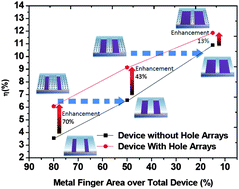In this paper we demonstrate a technique for improving the conversion efficiency in conventional silicon solar cells by using surface plasmon resonance (SPR) effects to harvest incident light energy over metal finger electrodes. According to three-dimensional finite-difference time-domain (3D-FDTD) analysis, incident light covering a broad bandwidth of the solar spectrum can be transmitted through metallic hole array structures. Although the light absorption region beneath the metal finger electrodes cannot generate a photocurrent, in this study, we employ the extraordinary transmission (EOT) phenomenon, due to SPR effects, to dramatically increase the degree of light harvesting below the metal electrodes and, thereby, improve the efficiency of the entire solar cell. Experimental data reveal that the excess photocurrent density was approximately 190% of the normal current density of a standard solar cell. Therefore, the negative effect of covering the absorption area with opaque metal finger electrodes can be minimized or eliminated completely by taking advantage of the SPR effect of the metal electrodes.

You have access to this article
 Please wait while we load your content...
Something went wrong. Try again?
Please wait while we load your content...
Something went wrong. Try again?


 Please wait while we load your content...
Please wait while we load your content...